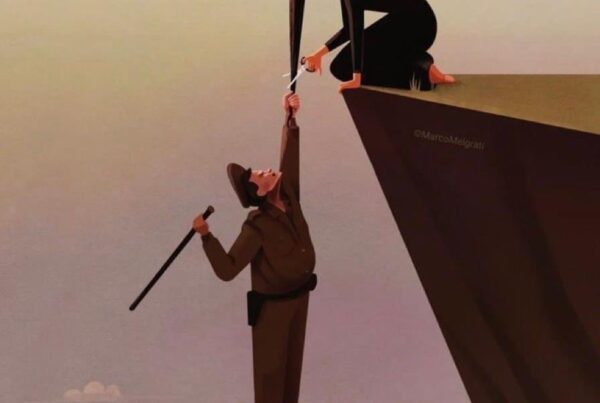How do nationalist eyes see a medieval Persian tragedy?
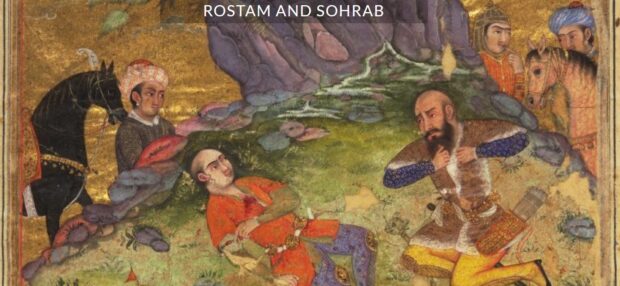
By: Asghar Seyed Gohrab
Ferdowsi’s Epic of the Kings (Shah-nama) is a monumental poem, often characterised as an identity document for the Persian-speaking peoples. Completed in 1010, this poem of more than 50,000 couplets still enjoys enormous popularity among Persians around the world. Ferdowsi depicts the legends, myths, history, etiquette, ethics and moral values of Iranian peoples from the dawn of creation to the arrival of Islam in the seventh century. The epic has inspired poets and other artists, and politicians and ideologues, who have used it for diverse purposes. Iranians in the diaspora retell some of its many episodes to their children to transmit a distinctly Persian way of life.
The Shah-nama is full of maxims, adages, reflections on life’s fluctuations, love stories and ponderings on the conundrum of death. It also devotes much attention to the relationships between man and woman, parent and child, and between the kings and their subjects. Ferdowsi’s main purpose is to recount a heroic story, but he interjects subtle and unresolved questioning about these relationships giving several episodes a tragic character. Perhaps the most popular story in the epic recounts how the Iranian Hercules, Rostam, unwittingly kills his own son Sohrab. A millennium later, Persian speakers still wrestle with this tragic ending, especially because Rostam is a model of magnanimity, chivalry and patriotism.
The Plot
The plot is intriguing, full of reflections on characters’ decisions with weighty consequences. Rostam is patrolling the border of Iran when his horse is stolen. He goes to enemy territory, Turan, in search of his horse. The local ruler receives him generously and promises to find the horse. He invites Rostam to stay for a night. Rostam accepts. When night comes on, he withdraws to his room. The princess Tahmine secretly joins him and reveals that she is in love with him and that she desires a child from him. They spend the night in loving embrace. Rostam gives her a bracelet and tells her that if the child is a daughter she should fasten it in the girl’s hair and if it is a boy, she should put the bracelet on his arm. The next morning, Rostam’s horse is found and he returns to Iran. A son is born and named Sohrab. When he becomes older, he is anxious to be reunited with his father. He goes to Iran with an army, hoping to see his father and to place him on the throne of Iran. The Persian generals conceal Sohrab’s identity from Rostam. They fight several times. When they meet, Sohrab asks Rostam to reveal his identity, which Rostam refuses, according to the rules of chivalry. In the first fight, the young Sohrab throws Rostam down, but a feeling of compassion overcomes him. In the next combat, Rostam throws Sohrab down. Fearing that the young warrior might stand up, he immediately thrusts his dagger into Sohrab’s side. The dying Sohrab says that his father, Rostam, will avenge him, even “if he becomes a fish in the sea or, becoming the night, disappears in darkness.” This is how Rostam learns the identity of his son.
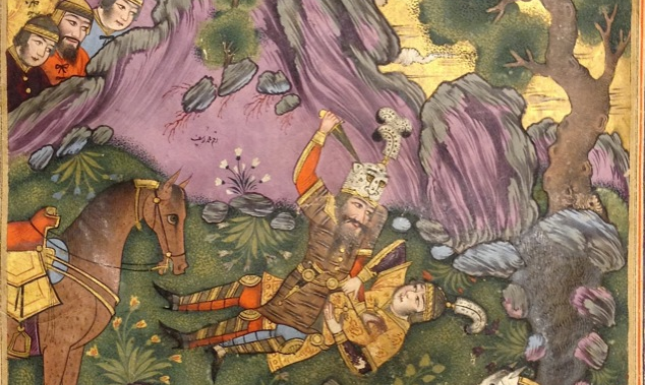
Modern Reception
The reception history of this story is fascinating. Popular story-tellers change the tryst between Rostam and Tahmina, who share a bed without being married, and with the girl taking the initiative. In tea or coffee-houses, story-tellers islamise this in various ways, even introducing an Islamic cleric to perform the marriage ceremony in the middle of the night. The reception history of the killing of Sohrab, the Sohrab-koshan episode, reveals a wide range of strategies to justify Rostam’s unforgivable deed. The Persian Shah-nama scholar Khatibi has gathered reports of audience responses when the story-teller approaches the killing of Sohrab. Some offered money to the story-teller, begging him not to tell the story, others leave the coffee-house so as not to hear the ending, and others again would visit a shrine, burning a candle with the prayer that Rostam may not kill Sohrab.
A recent reading of this scene is by the exile poet Alireza Shojaʿpour, based on his own personal experience. He recites part of his poem in a four-minute video posted on YouTube, and this video has gone viral on Social Media. He explains how one day, when he picks up his eight-years-old son from school, his son avoids telling him what he has experienced that day, and is anxious to know whether Rostam dies first or Sohrab. Shojaʿpour thinks of strategies to avoid telling the tragic scene. How, he wonders, ‘can I tell my son in a foreign land that he should be proud of Rostam, who kills his own son?’ ‘How could my son sleep in the same room with his father when he hears that Rostam kills his own son?’ Shojaʿpour is so engaged with these thoughts that he dreams of Rostam who tells him what really happened and why he killed Sohrab:
| I was dreaming I dreamed that I was with Rostam. Full of grief at the story of killing one’s child, I was talking to the champion, I said: “O ancient champion of the span of history … O victor on the stage of history I read the story of Rostam and Sohrab Reading the story, I was adrift in a shoreless ocean, on waves of outrage and anger. Evidently, Sohrab cherished a love … for Rostam in his heart … But in Rostam’s heart, there was little love for his son. (…) Whoever has read this story, with a bleeding heart, has attacked Rostam, saying, ‘Why did he not recognize Sohrab?’” But Rostam answered: “I knew from the beginning … That that broad chest and shoulders must be Sohrab’s, And what was shining on my soul like the sun, was the sun of Sohrab’s face. I saw on the young steed, on that day, a young Rostam. I speak the truth, in the fight I saw an enfeebled Rostam. During the banquet, on the night before the battle, I watched through an opening in the tent. The Turanians were celebrating on the soil of Iran. I saw that sturdy warrior … wearing no armor, I saw the bracelet marking his birthright, floating on the sea of his arms. Amid the waves of bewilderment and doubt consuming my endurance, I clearly saw that tall and mighty mountain. It was true, it was true, what people had said: in the army of our land …, although it trains champions and burns enemies, … I could not find a single one, chivalrous, skilled in battle and agile in throwing a lance, to match that sturdy knight. (…) When he threw me down on the ground, Woe to Rostam, Woe to Rostam …!!! I saw by his upraised hands, the flag of the royal house turned upside down …!! I saw the Iranian army and Iran in the hands of vile Turan I saw the soil of Iran ruby-stained, with pure Iranian blood. I saw the open plain a sea of blood. And I saw myself being tested in that sea of blood. In the deadly silence of the plains, A cry was poured in the ear of my soul, [as if] a drug was poured in the marrow of my bones. [as if] someone was shouting feverishly to me …: “Champion, wake from this sleep … This is not a war between Rostam and Sohrab … What is going on today, on this battlefield, is the war between Iran and Turan. In the first battle, before Sohrab’s blade could tear my heart, I myself killed Rostam with my own hands … in the midst of the struggle … Rostam, beware!!! Next morning, during the second fight, … To give a lesson in patriotism for [Iranian] champions the dagger of the Iranian hero tore the chest of Turan’s hero: in my fist a bloody dagger; In two battles, I killed Rostam and Sohrab. What remained, all that remained, to the world’s last eternity, was that master and chief delight of the cycles of history: It was Iran, It was Iran …” |
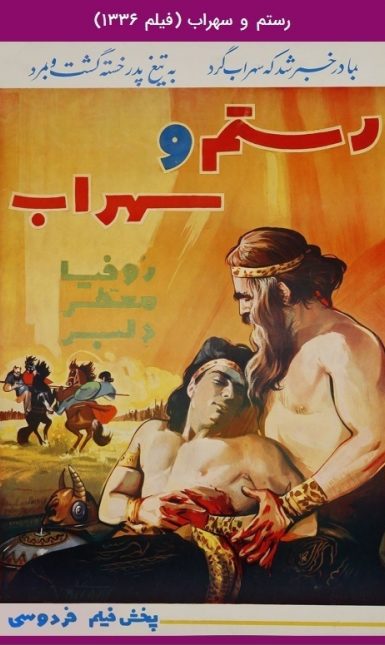
Nationalist Sentiments
The popularity of this video illustrates the continuing centrality of the Shah-nama to Iranian identity, and how many readers are seeking an answer to the problem of justice and duty that Ferdowsi connects to human interactions. At one level, Ferdowsi depicts the politics between two empires and how each desires worldly gain, whereas at another level, the poet focuses on human behaviour. Ferdowsi shows how human machinations in a conflicting political setting causes a catastrophe in personal relationships. At the beginning of the story, Ferdowsi asks the question, whether death is just or unjust? When a fierce wind (an allusion to Rostam) blows and casts down unripe citrus (an allusion to Sohrab), is this removal of the fruit virtuous or does it lack any virtue? Such questions are pointing to the lies, intrigues, and schemes that cause the killing of Sohrab. Ferdowsi is interested in human nature and how the choice for worldly power and position may lead to pain, misery and death. In the same way that there is a one-to-one relation between the fierce wind and the unripe citrus fruit in Ferdowsi’s prologue, there is also a parallel between Rostam’s behaviour and the politics of the Iranian king. Dick Davis points out the parallel between “the destruction of the son by the father and the deterioration of relations between monarchs and subject/champion” (1992:106).
Shojaʿpour’s poem possesses poetic merits and flavour, appealing to nationalistic sentiments. Shojaʿpour justifies death by placing patriotism to the fore. To remove the enemy, one should even sacrifice one’s child. Shojaʿpour overlooks the convoluted and problematic layers of the original story and frames it as a test of patriotism, focusing on Iran, a country attacked from within by a repressive theocratic regime, and from abroad by sanctions and isolation. Such readings give Shah-nama a modern nationalist appreciation. The poem is couched as a dream vision in which Rostam speaks from an invisible world. While this device gives authority to the poem, it remains a dream, not a reality. The entire dream is a way of reconciling the poet’s uneasy feeling with Rostam’s unforgivable action.
I find this problematic. As an academic, I find it hugely interesting to study the current reception of Ferdowsi’s monumental epic. But personally I have difficulties with readings that promote recourse to force rather than contemplation, duty to country over human bonds, that sustain pride rather than an awareness of human deficiencies and folly. Ferdowsi himself does not link this tragic story to nationalistic sentiments but rather gives it a philosophical take, alluding to man’s shortcomings and inability to identify his own flesh and blood. Several Persian painters have depicted this scene in mesmerising miniatures, emphasizing how the horses of the father and the son are screaming to warn them. Ferdowsi’s words are filled with wisdom:
| O world! How bewildering are your ways:It is you who sometimes break, sometimes heal.No love was triggered in either of them:As wisdom was far away, love did not show her face.An animal always recognises its child,Be it a fish in the sea, or a horse on the plains.No man can distinguish his own child from the enemy,When he is overcome by greed or grievance. | جهانا شگفتی ز کردار تستهم از تو شکسته هم از تو درستازین دو یکی را نجنبید مهرخرد دور بد مهر ننمود چهرهمی بچه را باز داند ستورچه ماهی به دریا چه در دشت گورنداند همی مردم از رنج و آزیکی دشمنی را ز فرزند باز |
The perpetual aesthetic delight of Ferdowsi’s poem lies in pointing to man’s limitations and how power, greed, and fame cloud his feelings and thoughts, even resulting in a catastrophic end. Shojaʿpour’s modern appreciation leaves less space for contemplation, whereas Ferdowsi offers his readers material to ponder, he poses questions for self-reflection.
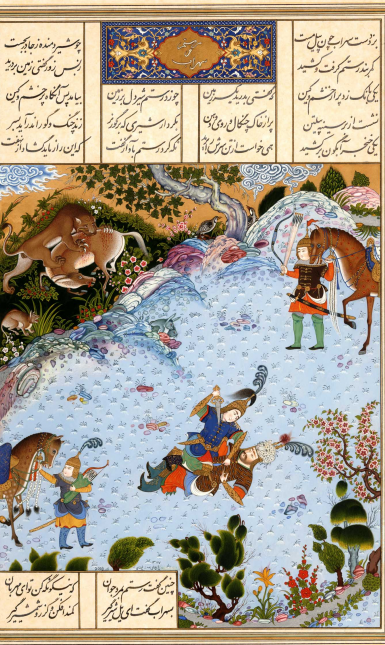
Recommended literature:
Clinton, J.W., The Tragedy of Sohráb and Rostám, Seattle: University of Washington Press 1987, revised edition 1987.
Cross, C., “‘If Death is Just, What is Injustice?’ Illicit Rage in ‘Rostam and Sohrab’ and the ‘Knight’s Tale’,” in Iranian Studies, Vol. 48, Issue 3, (2015), pp. 395-422.
Davis, D., Epic and Sedition: The Case of Ferdowsi’s Shāhnāmeh, Fayetteville: University of Arkansas Press, 1992.
Ferdowsi, Abo ’l-Qāsem, Shahnameh, 8, Vols., ed. Khaleghi-Motlagh, Costa Mesa, California: 1366/1987, Vol. II, pp. 171-72.
Ferdowsi, Abo ’l-Qāsem, Shahnameh: The Persian Book of Kings, Translated by D. Davis. London: Penguin, 2006, 2007; New York: Penguin, 2016. (for splendid illustrated translations of this epic see the following titles, The Lion and the Throne: Stories from the Shahnameh of Ferdowsi, Vol. 1. Washington, DC: Mage Publishers, 1997; Fathers and Sons: Stories from the Shahnameh of Ferdowsi, Vol. 2. Washington, DC: Mage Publishers, 2000; Sunset of Empire: Stories from the Shahnameh of Ferdowsi, Vol. 3. Washington, DC: Mage Publishers, 2004).
Khatibi, Abol-Fazl, “Aya Rostam Sohrab ra shenakhta bud,” available at Farhang-e emruz.
Lewis, F., (2015) “The Shahnameh of Ferdowsi as World Literature,” in Iranian Studies, Vol. 48, Issue 3, (2015), pp. 313-336.
Seyed-Gohrab, A.A., “Corrections and Elaborations: A One-Night Stand in Narrations of Ferdowsi’s Rostam and Sohrāb,” in Iranian Studies, Vol. 48, Issue 3, (2015), pp. 443-461.
© Asghar Seyed Gohrab and Leiden Medievalists Blog, 2020. Unauthorised use and/or duplication of this material without express and written permission from this site’s author and/or owner is strictly prohibited. Excerpts and links may be used, provided that full and clear credit is given to Asghar Seyed Gohrab and Leiden Medievalists Blog with appropriate and specific direction to the original content.
Source: leidenmedievalistsblog

